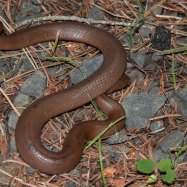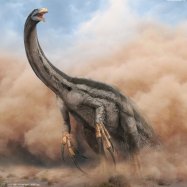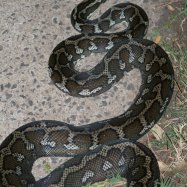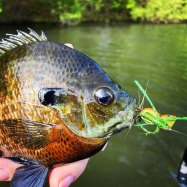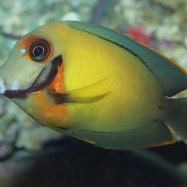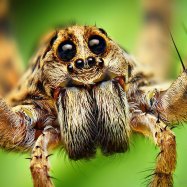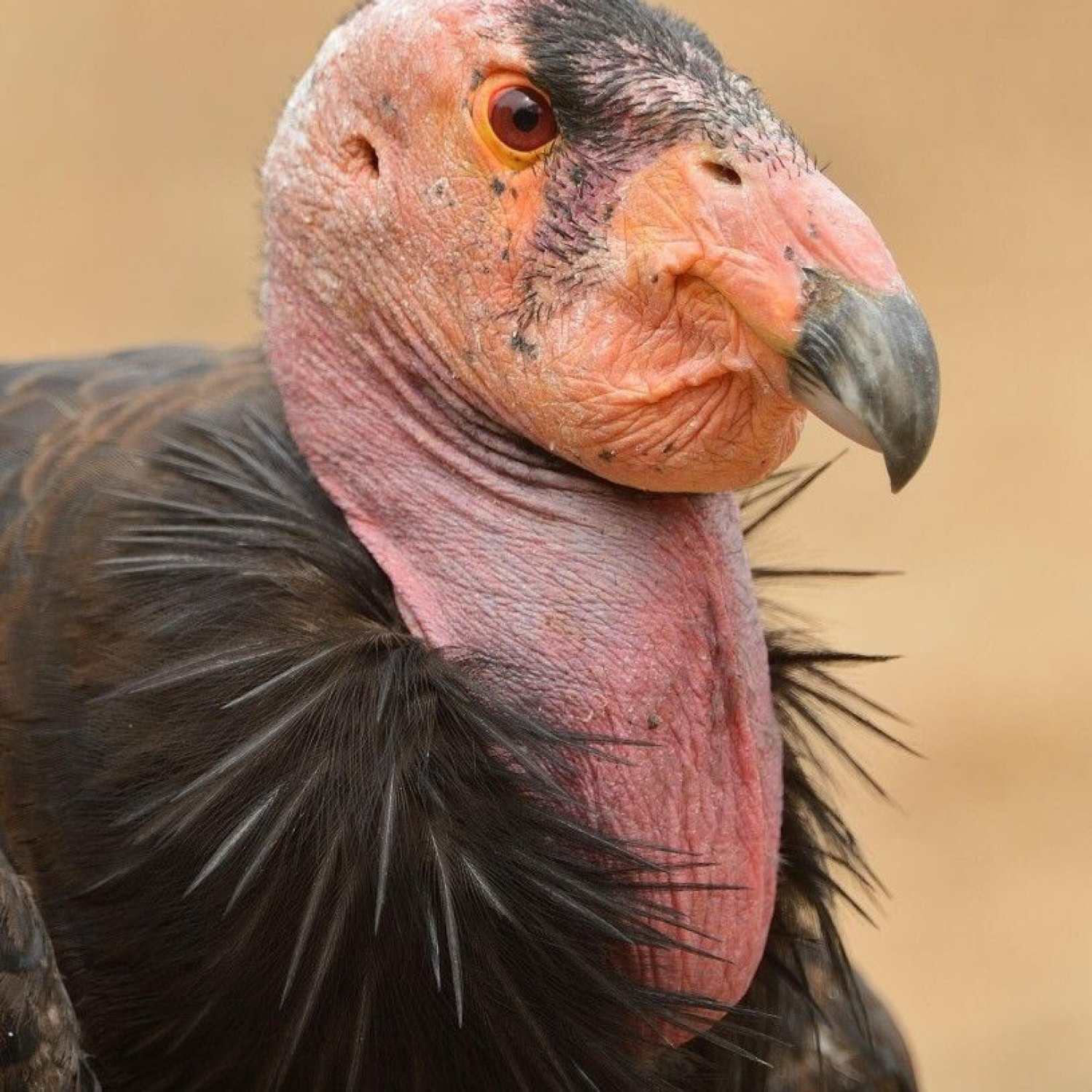
California Condor
46 to 55 inches (117 to 140 centimeters)
The California condor is a magnificent bird with a wingspan of up to 9.5 feet (2.9 meters). Found in California and Arizona, this large bird belongs to the Cathartidae family and can grow 46-55 inches (117-140 centimeters) in length. Let's protect and appreciate these amazing creatures in their natural habitat. #CaliforniaCondor #WildlifePreservation #BirdLovers
Animal Details Summary:
Common Name: California Condor
Kingdom: Animalia
Habitat: Mountainous and coastal regions
The Magnificent and Endangered California Condor: A Tale of Resilience
The California Condor, also known by its scientific name Gymnogyps californianus, is a majestic bird that captures the imagination with its impressive wingspan and stunning black and white coloration. Once nearly extinct, this species has made a remarkable comeback thanks to conservation efforts, making it a symbol of resilience and hope.With its wide geographic distribution in North America, the California Condor has captured the hearts of many nature enthusiasts and researchers. Let us dive deeper into the world of this fascinating bird and learn more about its unique features and conservation story California Condor.
Taxonomic Classification
The California Condor belongs to the Animalia kingdom, the Chordata phylum, and the Aves class. It is classified under the Accipitriformes order and the Cathartidae family. The scientific name Gymnogyps californianus is a combination of the Greek words "gymnos", which means "naked", and "gyps", which means "vulture". This name refers to the bare skin on the bird's head.Habitat and Distribution
The California Condor is found in mountainous and coastal regions, mainly in the southwestern United States. They are endemic to North America and are mostly found in California and Arizona. These birds have been observed in rugged landscapes, such as rocky cliffs, canyons, and deserts. They use thermal winds to soar and glide, and are most commonly seen flying over open areas in search of food.When not foraging for food, California Condors roost in large trees or on cliff ledges, often in communal groups Christmas Beetle. They have also been known to use man-made structures such as power poles as roosting sites.
Feeding Behavior
The California Condor is a carrion feeder, which means it mainly feeds on the carcasses of dead animals. By feeding on carcasses, they play a crucial role in the ecosystem by helping to clean up decaying matter and preventing the spread of diseases. They have a keen sense of smell, and can locate carcasses from great distances with the help of their exceptional vision.California Condors are also known to engage in a behavior called "obligate cooperative foraging", where group members work together to find and feed on large carcasses. This cooperative behavior is crucial for the species' survival, as it allows them to access food sources that would be too challenging for a single bird to handle.
Appearance and Physical Characteristics
The California Condor is a large bird with a wingspan of up to 9.5 feet (2.9 meters) and a weight of up to 26 pounds (11.8 kilograms). They have a distinctive black coloration with white feathers on the underside of their wings, making them easy to spot in the sky. Adult birds also have a featherless, pinkish-red head and a triangular, hooked beak.Young California Condors have a blackish-brown coloration, which gradually turns into the iconic black and white as they mature. They also have a grayish-blue ring around their neck, which fades as they age.
Conservation Status
The California Condor is listed as critically endangered on the International Union for Conservation of Nature (IUCN) Red List. At one point, it was estimated that there were only 22 California Condors left in the world, making it one of the most endangered species on the planet.The decline of the California Condor population was primarily due to factors such as hunting, habitat loss, and environmental pollutants. Efforts to conserve the species began in the 1980s, and today, there are approximately 500 individuals in the wild, thanks to intensive conservation efforts. However, the population is still considered vulnerable, and ongoing conservation efforts are critical to the survival of the species.
Success Story: California Condor Recovery Program
The recovery of the California Condor is one of the most remarkable conservation success stories in recent times. In the 1980s, the population had drastically declined due to various factors, including lead poisoning from ingesting ammunition residues, habitat destruction, and hunting. By 1987, only 22 individuals remained in the wild, prompting a drastic measure - bringing them into captivity for a breeding program.The California Condor Recovery Program was initiated in 1987, and the remaining wild birds were taken into captivity for breeding and reintroduction into the wild. This program involved extensive collaboration between government agencies, conservation organizations, and zoos.
The breeding program proved to be successful, and by 1992, the first captive-bred California Condors were reintroduced into the wild. Since then, numerous birds have been released, and the population has been steadily increasing. As of 2021, there are over 300 condors in the wild, with over 200 in captivity.
The California Condor Recovery Program continues to monitor, protect, and manage the released birds, in addition to ongoing research to understand the species' behavior and biology better. These efforts have not only helped in the species' recovery, but they have also helped bring public awareness to the importance of protecting and conserving these birds and their habitats.
Challenges and Future Conservation Efforts
Despite the success of the recovery program, California Condors still face numerous challenges to their survival. One of the most significant factors is lead poisoning, which remains a significant threat to the species. Condors feeding on carcasses of animals killed by lead ammunition are at risk of lead poisoning, which can be fatal.To tackle this issue, legislation was passed in California and Arizona to ban lead ammunition in the California Condor's range, followed by a voluntary lead reduction program for hunters. These efforts have led to a significant decrease in lead-related deaths among condors, but the problem persists. Ongoing efforts to educate the public and hunters about the dangers of lead ammunition and promote the use of non-toxic alternatives are crucial for the species' survival.
Another significant challenge for the California Condor is habitat loss and fragmentation. As human development and activities continue to expand, the birds' habitat is threatened, making it difficult for them to find suitable roosting and foraging areas. Conservation efforts are underway to protect and restore their habitat, but this remains an ongoing challenge.
The Role of Technology in Conservation
Advancements in technology such as GPS tracking and remote camera monitoring have played a vital role in the recovery and protection of the California Condor. GPS tracking allows researchers to monitor and study the birds' behavior, movements, and survival rates, providing valuable insights for conservation efforts. Remote camera monitoring also helps in monitoring the condors' activity and provides an opportunity to observe their behavior without disturbing them.Additionally, the use of AI and machine learning in analyzing data collected from tracking and camera monitoring has also proved invaluable in understanding the species' behavior and predicting potential threats.
The California Condor: A Symbol of Resilience and Hope
The California Condor's recovery is a testament to the power of conservation efforts and the resilience of nature. With ongoing efforts to protect and restore their habitat and promote awareness of the dangers they face, we can ensure that future generations will continue to be able to witness this magnificent bird soaring in the wild.As human activities continue to impact the environment and other species, the success story of the California Condor serves as a reminder of the crucial role we all play in protecting and preserving our planet's biodiversity. Let us learn from this triumph and continue to work towards a better, more sustainable future for all living beings.

California Condor
Animal Details California Condor - Scientific Name: Gymnogyps californianus
- Category: Animals C
- Scientific Name: Gymnogyps californianus
- Common Name: California Condor
- Kingdom: Animalia
- Phylum: Chordata
- Class: Aves
- Order: Accipitriformes
- Family: Cathartidae
- Habitat: Mountainous and coastal regions
- Feeding Method: Carrion feeder
- Geographical Distribution: North America
- Country of Origin: United States
- Location: California and Arizona
- Animal Coloration: Black with white feathers on the underwing
- Body Shape: Large bird with a wingspan of up to 9.5 feet (2.9 meters)
- Length: 46 to 55 inches (117 to 140 centimeters)

California Condor
- Adult Size: Very large, weighing up to 26 pounds (12 kilograms)
- Average Lifespan: Up to 60 years in captivity
- Reproduction: Sexual
- Reproductive Behavior: Monogamous
- Sound or Call: Graceful hissing or grunting sounds
- Migration Pattern: Migratory
- Social Groups: Form small groups or pairs
- Behavior: Solitary and shy
- Threats: Habitat loss, lead poisoning, and collisions with power lines
- Conservation Status: Critically Endangered
- Impact on Ecosystem: Important for the ecosystem as they help clean up carcasses and promote nutrient recycling
- Human Use: Symbol of conservation efforts and ecotourism
- Distinctive Features: Bald head and large size
- Interesting Facts: 1. California Condor is one of the largest flying birds in the world. 2. California Condors were on the brink of extinction in the 1980s, but conservation efforts have helped increase their population. 3. They have a long lifespan of up to 60 years. 4. California Condors were sacred birds to Native American tribes.
- Predator: No natural predators, but young birds may be vulnerable to predation by eagles or large mammals
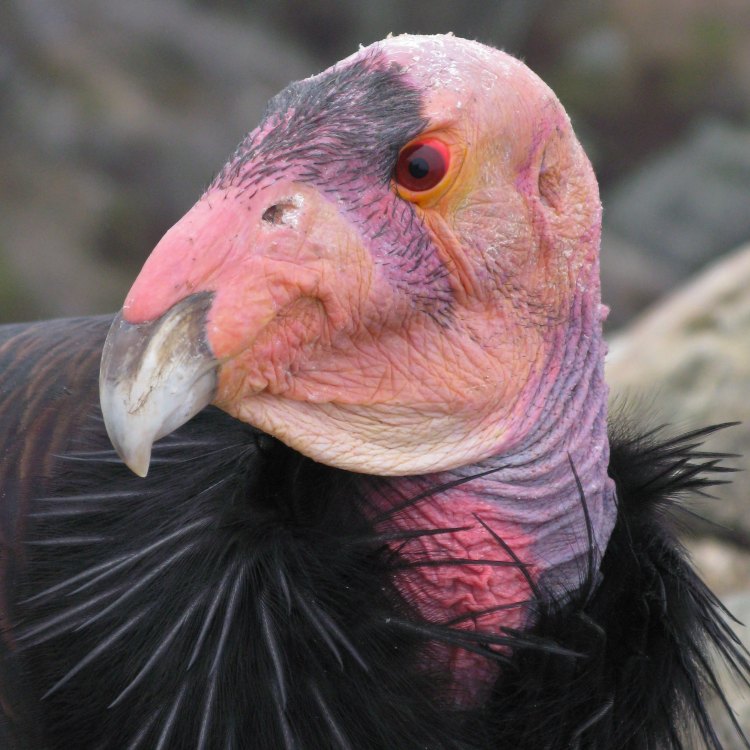
Gymnogyps californianus
The Majestic California Condor: A Symbol of Conservation Efforts and an Essential Part of the Ecosystem
In the rugged landscapes of California, a magnificent bird soars gracefully through the sky. With its massive wingspan and bald head, the California Condor is an iconic species that symbolizes strength, survival, and conservation efforts. These birds have a rich history deeply intertwined with the land and its people. But despite their majestic presence, California Condors are facing numerous threats and are currently listed as critically endangered PeaceOfAnimals.Com. In this article, we will explore the unique features and importance of this incredible creature in the hope of raising awareness and promoting conservation efforts.The California Condor is a member of the New World vulture family and is one of the largest flying birds on earth. They can reach impressive sizes, weighing up to 26 pounds (12 kilograms) and have a wingspan of up to 9 feet (2.7 meters). These impressive birds use their large wings to glide effortlessly through the air, reaching speeds of up to 55 miles (88 kilometers) per hour. Their distinctive physical features, including a bald head and featherless neck, give them a unique and striking appearance.
These incredible birds have an average lifespan of up to 60 years in captivity, with some individuals recorded to have lived even longer. In the wild, their lifespan may be shorter due to various threats. But despite their large size and long lifespan, California Condors are monogamous and form strong pair bonds with their mates Coral. This reproductive behavior is vital for their survival as they only breed once every two years, with one egg per breeding season.
The California Condor's call is a graceful hissing or grunting sound, which they use to communicate with their mates and other Condors in their group. These birds form small social groups or pairs, and while they are not typically social creatures, they do rely on each other for survival and protection.
The California Condor is a migratory species, with an impressive migration pattern that spans over hundreds of miles. They are known to travel across the western United States and Mexico in search of food and suitable breeding grounds. But despite their ability to travel long distances, they are shy and solitary birds, often avoiding human contact and disturbance.
Unfortunately, California Condors face numerous threats that have led to their critically endangered status. Habitat loss due to human development, lead poisoning from consuming carcasses containing lead bullets, and collisions with power lines are some of the main threats to these birds. These threats have caused a severe decline in their population, and by the 1980s, California Condors were on the brink of extinction.
Thankfully, conservation efforts have helped increase the California Condor population. The California Condor Recovery Program, started in 1987, focused on protecting and breeding these birds in captivity to eventually release them back into the wild. This program has been successful, with the current population standing at approximately 500 individuals. However, this critical species still faces ongoing threats, and conservation efforts must continue to ensure their survival.
Aside from their cultural and ecological significance, the California Condor plays a vital role in the ecosystem. As scavengers, they help clean up carcasses and promote nutrient recycling, which is important for maintaining a healthy ecosystem. Their presence benefits the entire ecosystem and highlights the interdependence of all species.
The California Condor has been an essential part of Native American culture for thousands of years. These birds were considered sacred and often featured in their religious and cultural ceremonies. They were also a source of inspiration for their impressive size and courage. Today, the California Condor continues to be an essential part of many Native American communities and serves as a symbol of conservation and the importance of protecting our environment.
The human use of California Condors has also played a significant role in raising awareness about conservation efforts and promoting ecotourism. Many organizations offer guided tours and educational programs to observe and learn about these magnificent creatures in their natural habitat. These initiatives help raise awareness and funding for conservation efforts and educate the public about the importance of protecting this species.
In addition to their significant role in the ecosystem, California Condors also have unique behavioral traits and interesting facts that make them even more fascinating. For example, they are one of the few species in the world that use tools. They have been observed using tree branches to reach inaccessible food sources. Also, unlike most birds, California Condors do not have a voice box, so they cannot sing. Instead, they make sounds by clacking their beaks together, allowing them to communicate with other Condors.
Another interesting fact about California Condors is that they have a special adaptation that allows them to conserve energy while flying. They have a thermoregulator, a network of blood vessels in their legs and wings, that control their body temperature. By regulating blood flow, they can moderate their body temperature and, therefore, save energy while flying long distances.
Furthermore, California Condors have no natural predators. Their sheer size and powerful wings make them formidable creatures in the sky. However, young Condors may be vulnerable to predation by eagles or large mammals, making their reproductive success even more crucial for their survival.
In conclusion, the majestic California Condor is a unique and iconic species that plays a vital role in our ecosystem. They are not only essential for maintaining a healthy environment, but they also serve as a symbol of conservation efforts and the interdependence of all living beings. While their population has increased in recent years, these birds still face many threats and need ongoing conservation efforts to ensure their survival. As responsible stewards of our environment, it is our duty to protect and preserve this magnificent creature, and in doing so, we protect our planet's biodiversity and natural beauty.
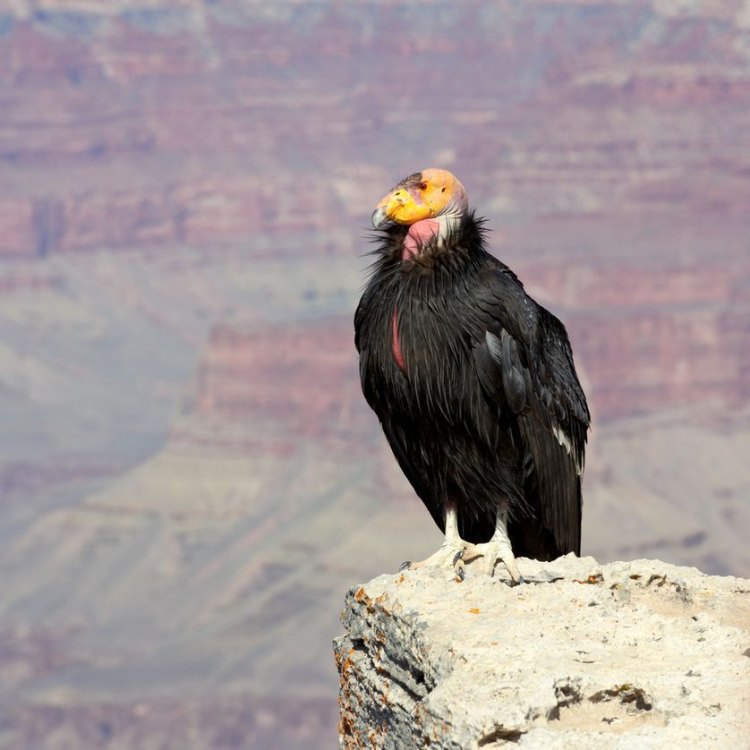
The Magnificent and Endangered California Condor: A Tale of Resilience
Disclaimer: The content provided is for informational purposes only. We cannot guarantee the accuracy of the information on this page 100%. All information provided here may change without prior notice.

